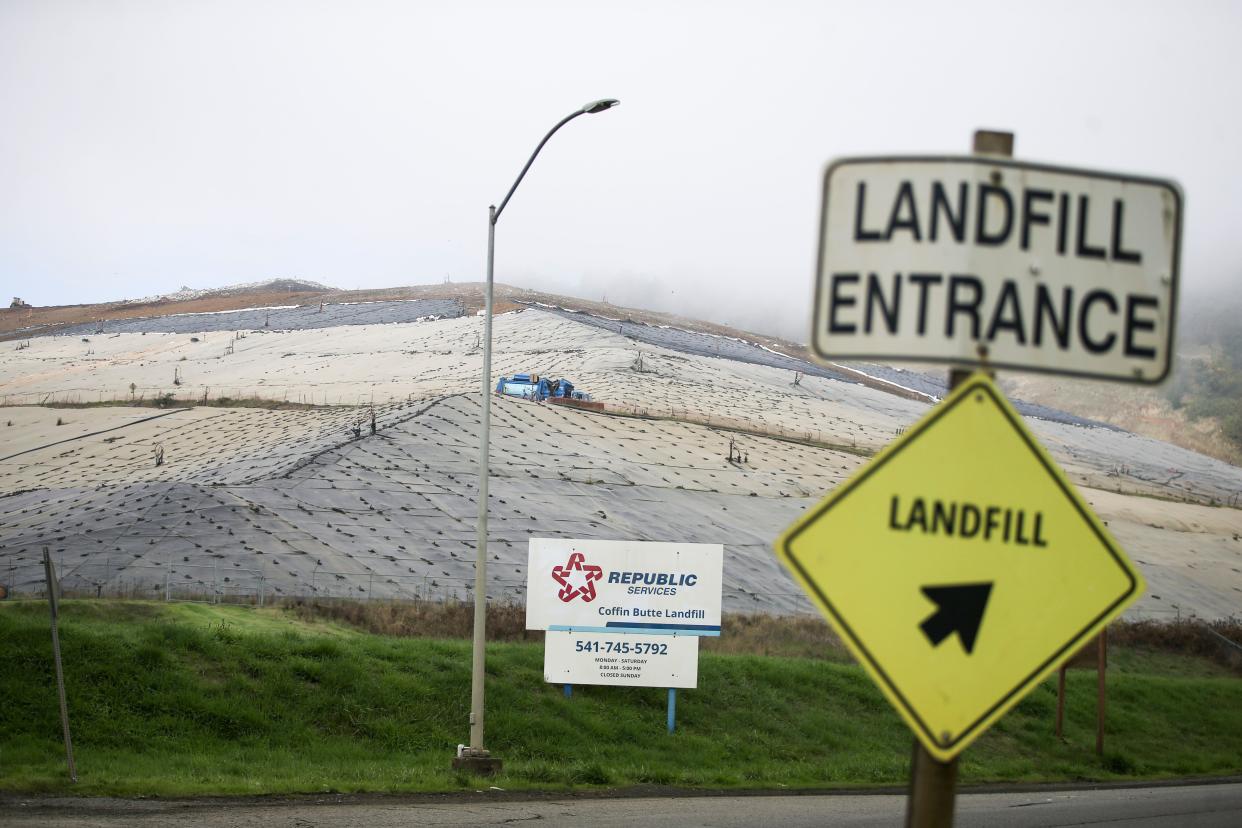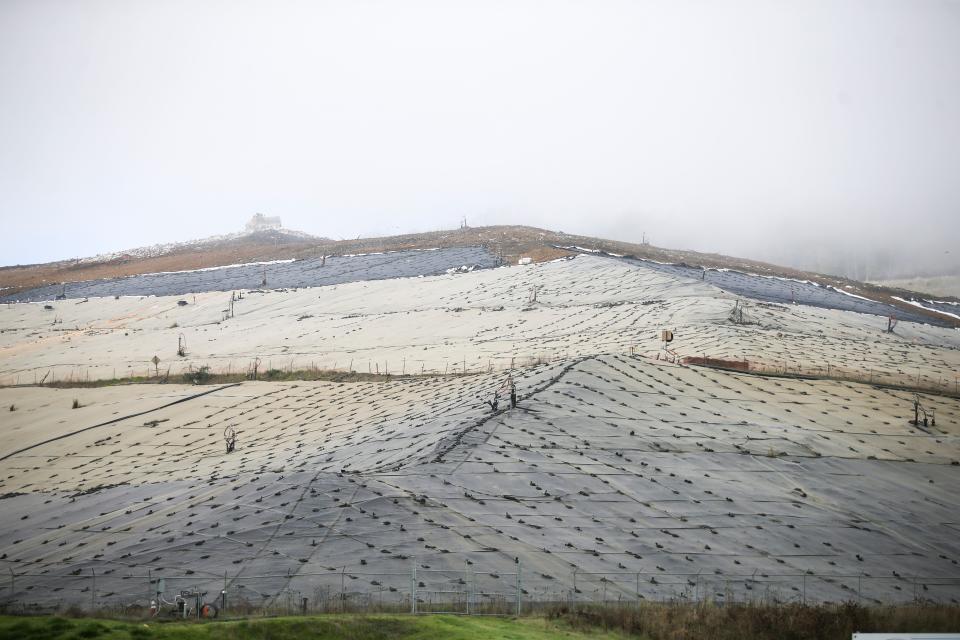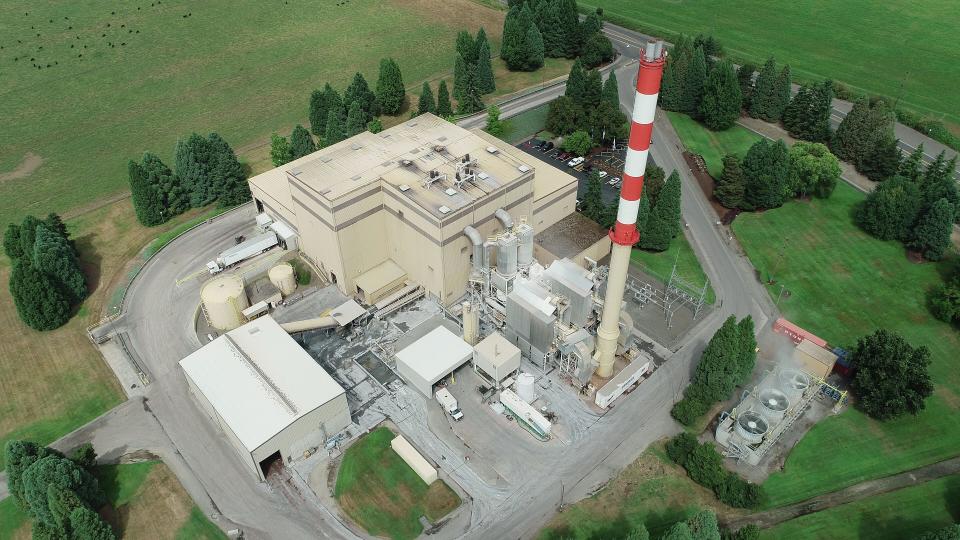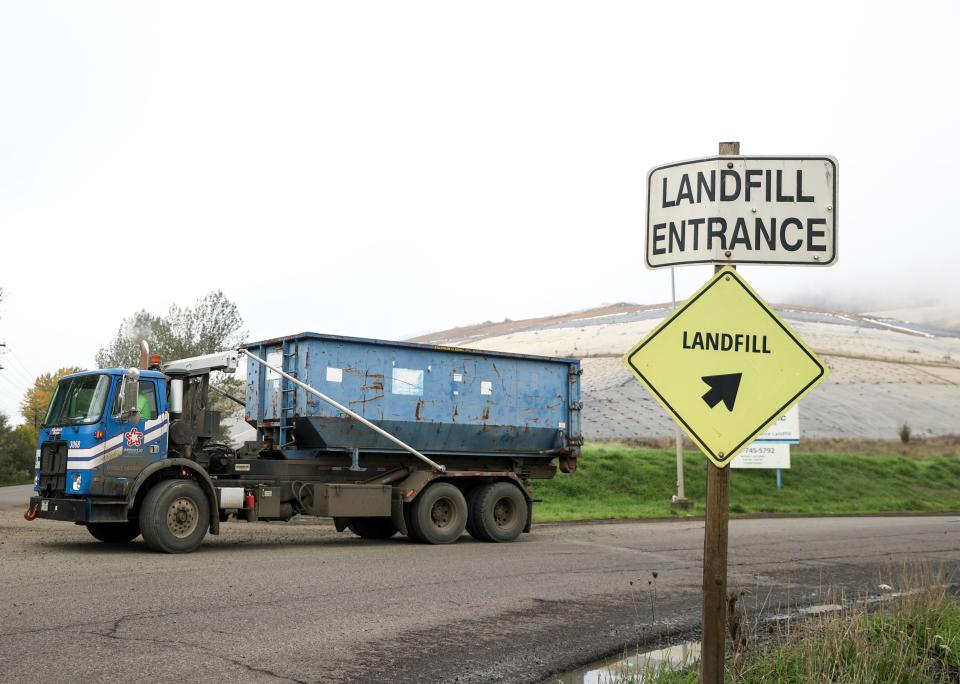Methane leaks at Coffin Butte Landfill in Oregon pose 'potential safety concern,' EPA says

Coffin Butte Landfill is leaking methane at levels that exceed state and federal limits and what the landfill has publicly reported, a U.S. Environmental Protection Agency inspection has found.
Landfills are among the nation’s largest sources of methane, a greenhouse gas that’s more potent than carbon dioxide and a major contributor to climate change, according to the EPA.
EPA measured methane exceeding regulatory limits 61 times during its June 2022 inspection of the landfill. Twenty-one of those exceedances measured at more than 10,000 parts per million, or 20 times the 500 ppm limit set by Oregon and the EPA.
In addition to contributing to climate change, the levels measured could cause health problems for neighbors, and in some cases were high enough to potentially cause an explosion and fire, said Lisa Arkin, of the Eugene-based environmental group Beyond Toxics.

Coffin Butte, located off Highway 99W north of Corvallis, is operated by Republic Services, the second-largest waste disposal company in the U.S. The landfill is an integral part of Marion County’s solid waste disposal system.
The inspection report noted there were so many exceedances that the inspector ran out of marking flags. In some cases, levels were so high instruments could not measure them. And multiple exceedances were measured several feet in the air, “indicating substantial landfill gas plumes,” according to the report.
Coffin Butte and local Republic Services officials acknowledged an interview request from the Statesman Journal but did not respond to any questions.
“While we have differing perspectives on the testing protocols and analyses from the EPA’s inspections in 2022, the EPA’s observations were addressed," Melissa Quillard a spokeswoman for Republic Services' media relations office in Phoenix said in an emailed statement.
"The landfill was already in the process of expanding the gas collection system at the time of the EPA inspection, which has since been completed. We added additional cover soil in some areas, added soil along the edge of tarps, patched small holes in a liner system, and strengthened seals around gas collection piping," she said.
EPA did not publicly release its inspection findings. Beyond Toxics, working with the climate group Industrious Labs, received a copy of the report in response to a request under the federal Freedom of Information Act.
The groups have since filed a complaint about the excessive methane emissions with EPA’s environmental violations tip line. Their complaint included photos taken by neighbors living near the landfill of holes and tears in tarps covering the landfill, which can allow methane to leak.
The findings come as Republic Services is considering a significant expansion of the landfill, which currently is permitted for 178 acres.
Coffin Butte Landfill's role in Marion County’s solid waste system
Much of Marion County’s garbage is burned at the Covanta municipal waste incinerator in Brooks.
About a quarter of the garbage burned at Covanta ends up as ash, which is trucked to Coffin Butte, to be used as “alternative daily cover.” Landfills are required to cover their active area at the end of each day to control vectors, fires, odors, blowing litter and scavenging.
About half of Coffin Butte's leachate — rainwater that trickles through the ash and garbage, picking up contaminants — then is trucked to the city of Salem’s wastewater system, where it’s treated and discharged to the Willamette River. The other half is treated by the city of Corvallis, which also discharges to the Willamette.
Salem began taking the landfill’s leachate in 2012. During the three years between January 2020 and December 2022, the city was paid $1.28 million to treat 42.6 million gallons of leachate from Coffin Butte, as well as a Republic Services' garbage transfer station in Benton County.

Salem also processes leachate from LRI Landfill in Graham, Washington, and Recology Organics compost facilities in Aumsville and North Plains.
Marion County garbage that doesn’t go to Covanta is taken to Coffin Butte, as is garbage from West Salem residents, who live in Polk County.
According to the landfill’s most recent annual report, Coffin Butte accepts more waste from Marion County than from any other county it serves. In 2021, the landfill accepted 326,000 tons of waste from Marion County, 143,000 tons from Linn County, 115,000 tons each from Benton and Lincoln counties, and 73,000 tons from Polk County.
Oregon's new landfill rules strictest in nation
Coffin Butte, along with other landfills, operates a gas capture system for the methane, which is created as organic waste decomposes. The landfill partners with PNGC Power to generate 5.66 megawatts of power from gas collected on site, providing enough electricity for about 4,000 homes.
In October 2021, the Oregon Department of Environmental Quality Commission adopted new rules regulating landfill gas emissions. Oregon now has the strictest monitoring and methane reduction standards in the nation.
But landfill operators are basically on an honor system to test and report, said Katherine Blauvelt, of Industrious Labs.
“The landfill has to follow through and conduct effective monitoring,” Blauvelt said. “That, in a nutshell is the real problem that this (EPA inspection report) is highlighting.”
EPA questions Republic Services' monitoring
EPA environmental scientist Daniel Heins expressed concerns in the report about Republic Services’ monitoring procedures.
In its monitoring reports, the company reported finding a total of six methane exceedances. Some reports had zero exceedances.
That compares with the 61 exceedances the EPA inspector found, “with 26 exceedances at gas collection wells that Republic should have specifically been monitoring on a quarterly basis," Heins wrote.
“Many flagged exceedances represented clusters of exceedances at multiple points or broad areas of exceedances,” he wrote.
Heins found an area where a tarp was visibly inflated with and leaking landfill gas.
“Along the top of this section of tarp … every post or tarp hole Daniel Heins monitored exceeded the surface methane standard, with readings of up to 7% (methane) shown before the instrument maxed out,” the report reads.
Heins noted “such an accumulation of flammable gas creates a potential safety concern.”

Heins was accompanied by Republic Services environmental specialist Phil Caruso. Neither could identify any place where the wind could be lifting the tarps, but Republic officials later “disputed that the tarps were inflated with landfill gas, claiming that the wind has blown them up,” according to the report.
Heins also found methane exceedances in areas of the landfill that are supposed to be under final closure and sealed, so that nothing can escape.
The inspection was pre-scheduled, and EPA had offered Republic Services the opportunity to take its own readings to check EPA’s monitoring results. Republic officials responded that it was company policy not to do so, according to the report.
“Phil Caruso did not dispute any of the readings, though noted that he would not have checked many of the exceedance locations, that he would have spent less time monitoring, or that he would have considered a higher location to be 'the ground' when placing his probe 5 to 10 centimeters above the ground per the surface emissions monitoring regulations,” Heins wrote in the report.
Further action on monitoring methane
EPA requested additional information from the company, but it’s unclear what further action the agency has taken.
"EPA is still in the process of evaluating compliance at the Coffin Butte Landfill based, in part, on the inspection report you referenced," EPA Region 10 spokesperson Sam Lovell said in an email to the Statesman Journal.
"EPA works closely with state and local Clean Air Act permitting agencies on these and other issues, and the agency will continue coordinating with Oregon DEQ regarding any next steps at this landfill," Lovell said.
Blauvelt said she filed a FOIA request with the EPA for additional legal documents associated with the case and was told none were available.
DEQ spokesman Dylan Darling referred specific questions about the report's findings to the EPA.
But, he said, "As part of DEQ’s new landfill rules and regulations, the company has indicated to DEQ that it is working on expanding its collection-and-control system. The company continues to provide monthly and semiannual reports to DEQ as required under their Title V air permit."
Advocates say Oregon and the EPA should require better methane monitoring with off-the-shelf technology such as drones or satellites.
“You can deploy technology that will act as reconnaissance and spot these super-emitter events, significant methane leaks, and then fix them,” Blauvelt said.
“We can use technology to at least overcome this baseline issue, which is we have no way of knowing whether you’re living next to a landfill that has really significant issues,” she said.
Tracy Loew covers the environment at the Statesman Journal. Send comments, questions and tips: tloew@statesmanjournal.com or 503-399-6779. Follow her on Twitter at @Tracy_Loew
This article originally appeared on Salem Statesman Journal: Coffin Butte Landfill methane leaks exceed state, federal limits

